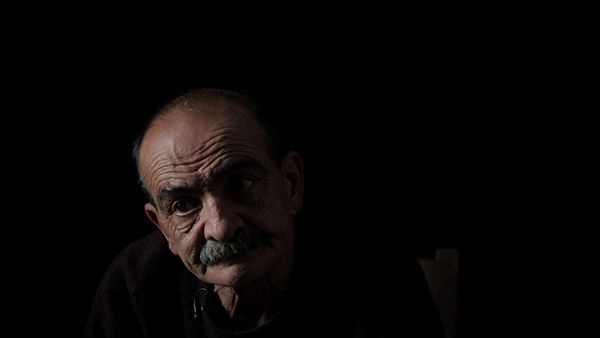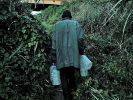Eye For Film >> Movies >> No Man's Land (2012) Film Review
No Man's Land
Reviewed by: Rebecca Naughten

No Man's Land (Terra de Ninguém) opens with a visual metaphor for the narrative we will be told - an aerial shot of woodland and a half-hidden long, winding road. The voice of director Salomé Lamas asks someone what they think the purpose of this film is - a male voice replies that he isn't sure, but that he wants to tell the story of his life and then everyone can think what they want. And so the 66-year-old José Paulo Rodrigues Sobral de Figueiredo (referred to simply as 'Paulo' within the film) recalls (or confesses) a life of violence and death - and Lamas offers an elucidation of memory (and its performance), history and authenticity.
Paulo joined the Portuguese army in 1966, serving as a commando in Africa during Portugal's colonial wars - his testimony specifically focuses on his time in Angola - and returning to his native country after the Carnation Revolution in 1974 (after which Portugal withdrew from its African colonies). He subsequently worked as security for high-ranking officials in Portugal before becoming a mercenary for hire in places such as El Salvador (at the request of the CIA) and later an assassin for the GAL operations in Spain.

Dressed in jeans and a dark pullover, Paulo sits centre frame on a chair in front of a black backdrop facing a static camera (Lamas occasionally cuts to medium close-ups of Paulo's head and shoulders but the camera doesn't move during a shot). The combination of backdrop and dark clothing draw attention to his weathered and expressive face but the film also serves as a fascinating record of body language - he crosses his arms and legs, leans forward or back into the chair, clasps his hands or sits with a hand on his hip and his elbows sticking out - as his every gesture emphasises his recollections and is captured by the camera. He does not mince his words ("I liked the army, I liked killing, I liked seeing blood") and largely speaks without recourse to euphemism or obfuscation - in fact he often seeks to educate his interlocutor in subtle differentiations (explaining the differences between security and a bodyguard or between mercenaries and hired killers).
The film is divided into the five days of their conversation (with a title cards listing the countries that will be discussed) and numbered sections which seem to correspond to Paulo's answers to questions that we don't hear. It initially seems that the film will concentrate on his time in Angola - it catalogues what are essentially war crimes - and the damage that participating in this level of trauma has evidently done to his own psyche (he explains that when he returned to Portugal, he used to sit in hospital emergency rooms in order to catch the scent of blood - "that sugary smell" - and get an adrenaline hit). But that period of his life is covered in the first day and more than half the film (sections 39 to 79 (out of 89)) relates to GAL.
If you are unfamiliar with the socio-political contexts of the conflicts Paulo acted within - and he moved around all over the world - parts of the film can be confusing because little background is given for the events he talks about (unless he chooses to elaborate himself). But Lamas expands on GAL sufficiently - quoting opinion pieces from the Spanish press during breaks from Paulo's story, in interludes that feature only her voice - that most viewers should be able to find their way through the story. GAL ('Grupos Antiterroristas de Liberación' [Antiterrorist Liberation Groups]) were illegal death squads set up by Spanish government officials to assassinate ETA members. The squads were active between 1983 and 1987, during the era when the Spanish Socialist Workers' Party (PSOE) was in power, and they operated in the Basque Country on both sides of the Spanish/French border. Throughout the film Paulo repeatedly returns to the phrase "for great evils, strong remedies" to justify his actions, but arguably this was the murkiest of the operations he was involved in and his reasoning is more obviously contradictory and uncertain.
It is at this point that Paulo's own identity comes in to question - who is he really? The film wanders through nebulous distinctions between veracity and authenticity, and the lines between historical and personal realities - and acknowledges that these are not static concepts. Paulo's retelling of his life story is effectively an enactment of these issues and through him the film seems to suggest that one flesh and blood individual necessarily both embodies those contradictions and reconciles them (at least to themselves). At the same time, the lack of context - and the absence of an onscreen challenge to Paulo's justifications and version of events, given that we don't hear Lamas's questions - serves the director's interest in Paulo's version of the truth as opposed to the historical record.
The numbered sections (which aren't explained) create a disjointed effect - which could be a reflection of the fragmentary nature of memories - but arguably the film loses some of its power in the final section, when Lamas dispenses with that framework and Paulo is no longer represented by his own words. With the stripped back aesthetic of a man sitting in front of the camera (and the story he has to tell), Lamas highlights the power of the much-maligned 'talking head' format of documentary while simultaneously striking out into less clearly defined territory aided by the shadowy life story of that same man.
Reviewed on: 22 Sep 2015
















